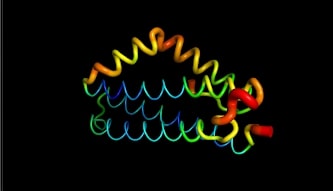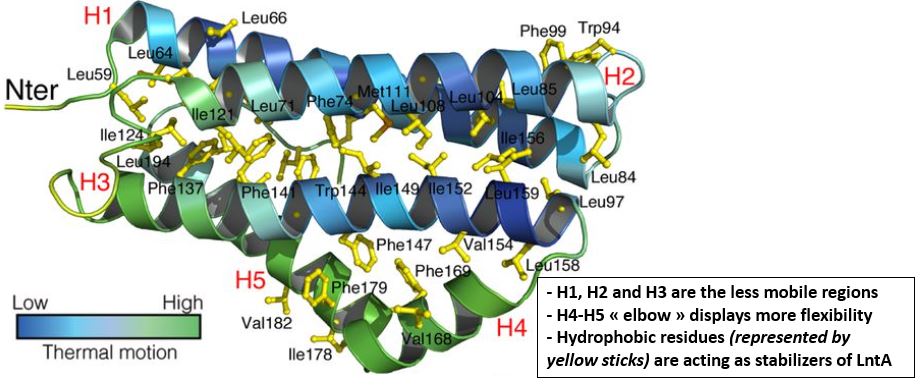Sandbox Reserved 1659
From Proteopedia
(Difference between revisions)
| Line 10: | Line 10: | ||
== Function== | == Function== | ||
| - | Once the bacteria reaches the host's cytoplasm, the expression of LntA is activated, the protein is excreted and addressed to the nucleus thanks to a peptide signal. Then, LntA interacts with the transcription factor | + | Once the bacteria reaches the host's cytoplasm, the expression of LntA is activated, the protein is excreted and addressed to the nucleus thanks to a peptide signal. Then, LntA interacts with the transcription factor BAHD1 [https://pubmed.ncbi.nlm.nih.gov/19666599/]. In absence of infection, BAHD1 represses the expression of ISG by promoting the local formation of heterochromatin while the interaction of LntA with BAHD1 has the effect of removing the chromatin repressor from the host’s DNA. Therefore, L. monocytogenes virulence factor induces a strong interferon response which enhances its pathogenicity[https://pubmed.ncbi.nlm.nih.gov/21252314/]. |
The mechanisms by which Listeria benefits from the synthesis of interferons are not fully understood. One hypothesis could be that Listeria monocytogenes takes advantage of the arrest of cellular-cycle induced by interferons. <ref>ROHDE JOHN R. Listeria unwinds host’s DNA. SCIENCE, 2011 : 1271-1272</ref> Indeed, this mechanism could be similar to those used by other pathogens such as Salmonella <ref>Winter SE, Thiennimitr P et al. Gut inflammation provides a respiratory electron acceptor for Salmonella. Nature. 2010</ref> or Yersinia <ref>Dewoody, R., Merritt, P.M., Houppert, A.S. and Marketon, M.M. (2011), YopK regulates the Yersinia pestis type III secretion system from within host cells. Molecular Microbiology, 79: 1445-1461. https://doi.org/10.1111/j.1365-2958.2011.07534.x</ref> which are able to promote an inflammatory response in gut epithelium in order to facilitate their dissemination and colonization. | The mechanisms by which Listeria benefits from the synthesis of interferons are not fully understood. One hypothesis could be that Listeria monocytogenes takes advantage of the arrest of cellular-cycle induced by interferons. <ref>ROHDE JOHN R. Listeria unwinds host’s DNA. SCIENCE, 2011 : 1271-1272</ref> Indeed, this mechanism could be similar to those used by other pathogens such as Salmonella <ref>Winter SE, Thiennimitr P et al. Gut inflammation provides a respiratory electron acceptor for Salmonella. Nature. 2010</ref> or Yersinia <ref>Dewoody, R., Merritt, P.M., Houppert, A.S. and Marketon, M.M. (2011), YopK regulates the Yersinia pestis type III secretion system from within host cells. Molecular Microbiology, 79: 1445-1461. https://doi.org/10.1111/j.1365-2958.2011.07534.x</ref> which are able to promote an inflammatory response in gut epithelium in order to facilitate their dissemination and colonization. | ||
In addition, Lebreton et al showed that when listeria grows outside the cell, the transcription rate of LntA is almost null and that a constitutive expression of LntA has an antibacterial effect. Thus, the efficiency of LntA requires a precise temporal and quantitative regulation. | In addition, Lebreton et al showed that when listeria grows outside the cell, the transcription rate of LntA is almost null and that a constitutive expression of LntA has an antibacterial effect. Thus, the efficiency of LntA requires a precise temporal and quantitative regulation. | ||
Revision as of 13:04, 20 January 2022
| |||||||||||
References
- ↑ ROHDE JOHN R. Listeria unwinds host’s DNA. SCIENCE, 2011 : 1271-1272
- ↑ Winter SE, Thiennimitr P et al. Gut inflammation provides a respiratory electron acceptor for Salmonella. Nature. 2010
- ↑ Dewoody, R., Merritt, P.M., Houppert, A.S. and Marketon, M.M. (2011), YopK regulates the Yersinia pestis type III secretion system from within host cells. Molecular Microbiology, 79: 1445-1461. https://doi.org/10.1111/j.1365-2958.2011.07534.x
- ↑ Lebreton A, Job V, Ragon M, Le Monnier A, Dessen A, Cossart P, Bierne H. 2014. Structural basis for the inhibition of the chromatin repressor BAHD1 by the bacterial nucleomodulin LntA
- ↑ Alice Lebreton. Régulations post-transcriptionnelles de l’expression génique de la cellule hôte en réponse à l’infection bactérienne. Sciences du Vivant, 2015


